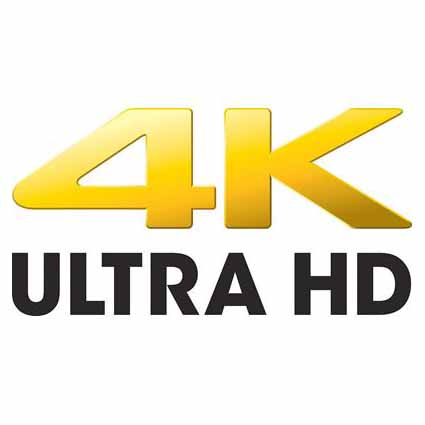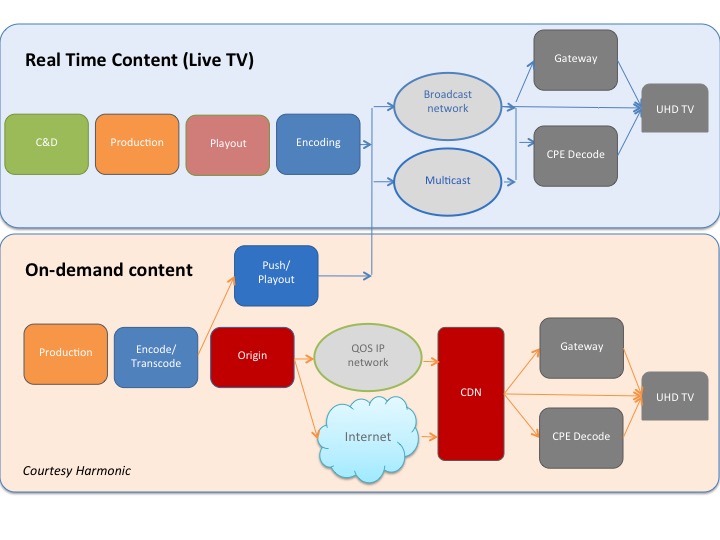
I attended the French HD Forum meeting on UHD last week in Paris, which hosted by Eutelsat. France prides itself on being innovative, often with government or strong regulator incentive. How this actually works out is a matter for politicians as in the case of the Minitel that predated the Internet. There is still no consensus on whether it was a good thing for France, with French people becoming used to eCommerce before the term even existed or whether on the contrary it made France miss the first Internet wave.
When it comes to TV standards similar debates rage. Much ink was spilt over the terrestrial switch-over which was completed here in 2011. The transition from SD to HD was always a political hot potato and is still underway with spectrum scarcity in the current DVB-T1 setup restricting HD to 5 of the 23 FTA channels.
Unsurprisingly, when the French get talking about UHD, there’s palpable tension with all the differing agendas. Does it make more sense to finish upgrading the end-to-end environment to HD before playing around with UHD, or on the contrary would it be more economical to avoid two upgrades and go straight to the ultimate target of full UHD? Should TV stations wait for customer demand or try to stimulate it with UHD services in as early as 2015?
Beyond these legitimate debates, there is also some confusion that is artificially created by a lack of information and sharing across the Ultra HD video ecosystem.
The risk of confusion
As UHD TV gradually tips over it’s peak of inflated expectations the TV industry at large, through the diversity of its reactions, will undoubtedly lead it down to the depths of disillusionment. Some TV stations publicly doubt if 4K will ever be a sound business proposition, while satellite operators and many technology vendors have bet their future on UHD success. Sometimes, even within the same industry group UHD is being pulled in several different directions at once as for example between the different UHD specifications of ITU, EBU, Digital Europe and CEA. Some key differences and commonalities are:
|
Feature |
ITU | EBU (phase 1) | CEA | Digital Europe |
|
Resolution |
4320p | 2160p | 2160p | 2160p |
| Frame rate | 120/60 | 60 | 60/30/24 | 60/30/24 |
| Color space | BT2020 | BT 709 | ||
| HDMI | NA | 2.0 | 2.0 | |
| Bit depth | 10/12 | 10 | 8 minimum | 8 minimum |
| HDR | Under standardization | Phase 2 | Not mentioned | Not mentioned |
The standardization of UHD has so far been much less chaotic than it was for say 3D technology at a similar stage.
Some clear standards emerging from:
- the telecoms sector with the (ITU-R) recommendation from ITU’s Study Group 6 (more at: http://www.tvtechnology.com/news/0086/itu-issues-uhdtv-standards-recommendations-/213615#sthash.DXG9J7bU.dpuf),
- the video technology space, which is also active with MPEG-HEVC having published a specification in January 2013 that can use used for UHD and that is now looking actively at HDR,
- the consumer electronics industry that provided a vital part of the Ultra HD requirements with the standardization of HDMI 2.0,
- the broadcasters, with the DVB/EBU ultra high definition broadcast format (UHD-1 Phase 1) specification for example.
But UHD’s success will rely on much more than just increased bandwidth and resolution and many of the other elements are still under discussion like for example the required increases in both color sensitivity and contrast with HDR (High Dynamic Range) or refresh rates with HFR (High Frame Rate). Norms for carrying higher definition audio with a greater number of channels have been standardized by ETSI with AC-4 that is actively promoted by Dolby. The MPEG standards body is currently in the process of creating an object based audio encoding standard with MPEG-H. The IP encapsulation techniques defined by SMPTE (2022-6) are still to be universally accepted by the industry.
To succeed faster, at a lower the cost for early adopters, UHD doesn’t need yet another body defining standards, but one that explains them, helps ensure their interoperability and promotes successful business cases.
After the failure of 3D, the industry needs to regroup around UHD to ensure its success, in a similar way the DASH Industry forum (dashif.com) has rallied all the DASH energies.
The Ultra HD ecosystem is quite complex and we provide here (courtesy of Harmonic) an end to end diagram for Ultra HD:
 To speed up the process of getting through the trough of disillusionment or maybe is it to cross the chasm, I learnt in Paris that a few market leading companies are in talks to set up an alliance. Its intended scope is to cover all parts of the content lifecycle from production to display, encompassing contribution, distribution, post-production and play-out. The Alliance’s stated goal will be to promote interoperable specifications, propagate effective business models, provide forecasting and share all successful application models.
To speed up the process of getting through the trough of disillusionment or maybe is it to cross the chasm, I learnt in Paris that a few market leading companies are in talks to set up an alliance. Its intended scope is to cover all parts of the content lifecycle from production to display, encompassing contribution, distribution, post-production and play-out. The Alliance’s stated goal will be to promote interoperable specifications, propagate effective business models, provide forecasting and share all successful application models.
The alliance would identify, describe and share specifications relevant to all parts of the distribution chain in close collaboration with standardization bodies.
Interoperability will be a key driver for all the alliance’s work, defining the system level interop points, organizing interop plug fests and publishing and promoting the results.
The Alliance would also deliver business models for both live and on-demand content, sharing any industry success stories and ensuring any mistakes are only ever made once.
An Ultra HD Alliance would promote existing industry reports but also pool real market data from its members and use projections to obtain the most accurate forecasts for critical market dynamics. The number of deployed UHD capable CPE, the readiness of live TV workflows or the extent of UHD VoD assets will be closely monitored and projected. The alliance also intends to show how UHD can be used in different application domains such as VoD, Live TV, Linear play-out, Push VoD, etc. presenting the benefits of UHD over HD with operator feedback.
To successfully promote Ultra HD, the alliance would be represented at trade shows and conferences. The alliance’s website would encourage interaction with blogging and social media. Webinars and various publications including whitepapers will also shorten UHD’s time-to-market.
The alliance would be open to companies from all parts of the ecosystem. Content providers, broadcasters, production houses, operators, playout companies, encoder vendors, audio specialists, security providers, chipset makers and UHD device manufacturers would all be able to join. Other organisations such as the HD Forum, EBU, DVB, etc. would be welcome too.
The setup of the alliance is still at the stage of informal talks, but the first formal meeting will take place at the CES in Las Vegas in January 2015.
Stay tuned for an update after the show (previous 4K blog on 7 Reasons why UHD/4K makes sense here)
